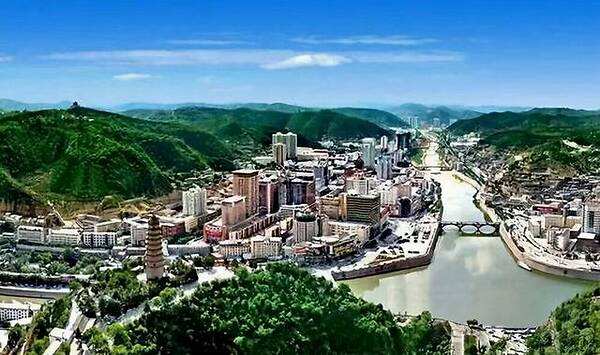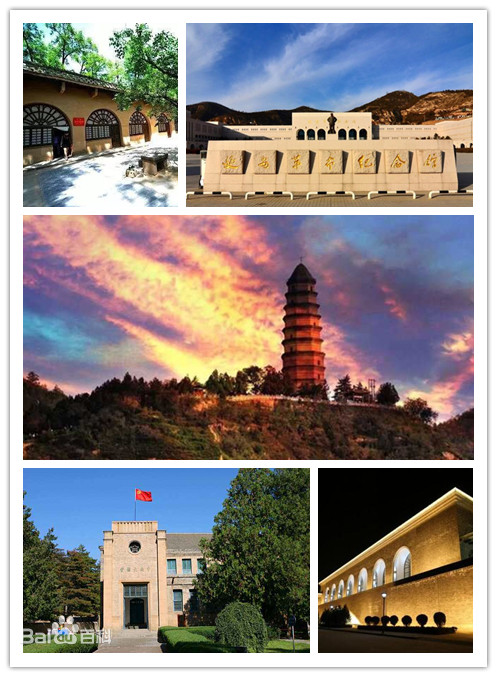
当前课程知识点:陕西导游英语 > 1. 美景篇 > 1.11 Yan’an Revolutionary Heritage Site 延安革命纪念地景区 > 1.10 Text 讲解词


Ladies and gentlemen, today we are going to visit Yan'an Revolutionary Heritage Site. First, please allow me to give you a brief introduction of Yan’an. Yan'an , also called Fushi in history, is located in northern part of Shaanxi Province , about 350 kilometers north of Xi'an . It is one of the most famous city in China's modern history and the history of the Chinese Communist Party.
Throughout history, Yan’an has been the political, economic, cultural and military center of north Shaanxi. So, one can find a lot of time-honored historic sites here. Yan’an’s attraction mainly lies in its “double yellowness and double sacredness” . The double yellowness refers to the Hukou Waterfall of the Yellow River and the Loess (Yellow Earth) Plateau folkways . Hailed as the sacred place of the Chinese revolution as well as of the Chinese nation, It therefore got the name “double sacredness”.
During the Anti-Japanese War period and China’s War of Liberation period, the Central Committee of the Communist Party of China (CCCPC) has left 140 historical relics and memorable sites of the revolution. Among these, five attractions constitute Yan'an Revolutionary Heritage Site, representing 445 revolutionary sites in Yan'an, and features the legacies of the CCCPC. The five attractions are the Baota Pagoda , Zaoyuan Revolutionary Site , Yangjialing Revolutionary Site , the Site of the CCCPC Northwest Bureau and the Yan'an Revolutionary Memorial Museum . The first generation of Chinese revolutionaries under the leadership of Mao Zedong stayed there after the Long March from 1935 to 1948. Yan'an's revolutionary sites amidst its arid landscape definitely give the city a special charm and tourist numbers continue to increase rapidly. Now, I’ll introduce these five attractions to you one by one.
The Baota Pagoda is a key landmark of the Yan'an Revolutionary Heritage Site. It was built between 766 and 779 during the Tang Dynasty (618-907). The nine-storey octagonal pagoda has undergone several major renovations throughout history and now stands 44 meters high with a perimeter of 36.8 meters. It is open to the public at the north entrance, from where they can ascend to the top and enjoy the best view of Yan'an and the surrounding Loess Plateau scenery.
However, the Baota Pagoda is not the only worthwhile site on the hill that covers a total area of 360,000 square meters. A huge iron bell that the Chinese Communists used as an alarm bell can be found right next to the pagoda. It is known as Ping'an Bell (Safety Bell) and was originally cast during the Ming dynasty. There is also a huge drum named Taiping Drum (Peace Drum) that visitors can beat. Every day, many tourists line up to beat the drum and ring the bell as both are believed to bring good health and happiness.
Located in 3 kilometers northwest of Yan’an, Yangjialing Revolutionary Site was merely a small village resided by fewer than 20 households during the Anti-Japanese War. On November 20, 1938, after Yan'an City was bombed by Japanese fighter planes, the functional department of the CCCPC was moved here from Fenghuangshan inside Yan'an, and stayed here between November 1938 and March 1947.
The most significant event in Yangjialing's tenure was the successful convening of the Seventh National Congress of the Communist Party of China in April 1945. Here the communist leaders launched the well-known Rectification Movement and the Great Production Campaign. During this period of time, Chairman Mao composed and released many important articles and was interviewed by American correspondent Anna Louis Strang(. It was during this interview that the phrase 'paper tiger' was made famous worldwide.
Yangjialing Revolutionary Site has become a popular tourist attraction not only because of its historical significance, but also because it symbolizes the spirit of liberation during hard times.
Zaoyuan Revolutionary Site was where the Secretariat of the the CCCPC sat between 1944 and 1947. It is located 8 kilometers northwest of Yan' an City and was once a manor owned by a Northern Shaanxi warlord named Gao Shuangcheng. It gained the name Zaoyuan which means yard of date trees simply due to the widely planted date trees. The garden has 22 caves, 100 tile roofted houses and a small hall of Russian styles, covering an area about 5 hectares.
In October 1943, the CCCPC moved here from the valley at Yangjialing . When its leaders, Mao Ze dong, Zhu De, Liu Shaoqi, Zhou Enlai, Ren Bishi, Zhang Wentian and Peng Dehuai, (图5-2) were once living here, they continued to lead the Party in the Rectification Movement, and in the Great Production Campaigns in the liberated areas. It was from here that our Party won the victory of the Anti-Japanese War, and led the army and people to fight for peace, democracy and unity, and struggled to disclose the Kuomintang's /'kwəu'min'tæŋ/ evil intention of false peace and true civil war.
Established in 1941, the CCCPC Northwest Bureau is located in Huashibian, the south of Yan'an. It was moved there from Zhangya Village in 1942 and moved away in 1947, during which Gao Gang, Peng Dehuai and Xi Zhongxun successively served as secretaries. It was responsible for dealing with affairs in the Shaanxi-Gansu-Ningxia Border Region and other provinces in Northwest China, and has made major achievements in strengthening party building and political power, improving economy and military strength.
The Yan'an Revolutionary Memorial Museum is a large museum that is located relatively close to the Yangjialing Revolutionary Site. Founded in 1950 and opened to the public in February 1951, it was one of the first revolutionary memorials built after the founding of the People's Republic of China in 1949 and was previously known as the Yan'an Revolutionary Museum.
The museum's focus are clearly the 13 years of revolutionary activities of the Communist Party of China and that is reflected in the selection of the 1,300 relics, audio and video material and more than 200 historic photographs that are on permanent display. It might be a good idea to make the Yan'an Revolutionary Memorial Museum the last stop during a Yan'an visit. This will help visitors to form a comprehensive perspective from all the information that was learned previously during the visits of Yan'an's various revolutionary sites.
These attractions of Yan'an Revolutionary Heritage Site, together with Yan’an spirit , the spirit of liberation, hard working and living on yourself during hard times, have all become part of Yan’an’s lingering charm today. It symbolizes the Communist Party’s philosophy of ‘plain living and hard struggle’ as well as maintaining the purity of party cadres. Image of Yan’an feeds into the discourse of ‘harmonious society’, without it China’s current modernization would not have been possible. In the modern era, Yan'an Spirit has been given new purposes and influences a new generation throughout the whole nation.
-1.1 Emperor Qinshihuang’s Mausoleum Site Museum 秦始皇帝陵博物院
--1.1 Test 测试
-1.2 Shaanxi History Museum 陕西历史博物馆
--1.2 Test 测试
-1.3 The Forest of Stone Tablets 西安碑林博物馆
--1.3 Test
-1.4 Xi’an City Wall 西安城墙景区
--1.4 测试
-1.5 The Huaqing Hot Spring 华清池景区
--1.5 测试
-1.6 The Big Wild Goose Pagoda 西安大雁塔
--1.6 测试
-1.7 The Tang Paradise 大唐芙蓉园
--1.7 测试
-1.8 The Great Mosque 西安清真大寺
--1.8 测试
-1.9 Famen Temple Buddhist Cultural Scenic Area 陕西法门寺佛文化景区
--1.9 测试
-1.10 The Yellow Emperor’s Mausoleum 黄帝陵景区
--1.10 测试
-1.11 Yan’an Revolutionary Heritage Site 延安革命纪念地景区
--1.11 测试
-1.12 Mount Huashan 华山风景名胜区
--1.12 测试
-1.13 Jinsi Grand Canyon Scenic Spot 金丝峡景区
--1.13 测试
-1.14 Taibaishan International Holiday Resort 太白山国际旅游度假区
--1.14 测试
-2.0 Prelude 引言
-2.1 Diced Pancake Boiled in Mutton & Beef Soup 羊肉泡馍
--2.1 Test 测试
-2.2 Xi'an Dumpling Banquet 饺子宴
--2.2 Test 测试
-2.3 Biang Biang Noodles 扯面
--2.3 Test 测试
-2.4 Pancake Stuffed with Marinated Pork 肉夹馍
--2.4 Test 测试
-2.5 Cold Noodles with Sesame Paste 麻酱凉皮
--2.5 Test 测试
-3.1 Shaanxi Local Specialties 陕西特色手工艺品
--3.1 Test 测试
-3.2 Qin Terracotta figures 兵马俑复制品
--3.2 Test 测试
-3.3 Stele Rubbings and Yaozhou Green ware 拓片和耀州瓷
--3.3 Test 测试
-3.4 Leather Shadow Puppets and Paper Cuts 皮影和剪纸
--3.4 Test 测试
-3.5 Shuyuanmen Cultural Street 书院门
--3.5 Test 测试
-4.1 The Tang Dynasty Music and Dance Show 仿唐乐舞
--4.1 Test 测试
-4.2 The Song of Everlasting Sorrow Evening Show 长恨歌
--4.2 Test 测试
-4.3 The Great Tang All Day Mall 大唐不夜城
--4.3 Test 测试
-5.1 Meeting with a Tour Group at the Airport 机场接机
--5.1 Test 测试
-5.2 Welcome Speech 欢迎词
--5.2 Test 测试
-5.3 Brief Introduction to Shaanxi and Xi’an 陕西及西安简介
--5.3 Test 测试
-5.4 On the Way to the Hotel 去钟楼饭店途中
--5.4 Test 测试
-5.5 Check in at Bell Tower Hotel 钟楼饭店入住
--5.5 Test 测试
-5.6 Discuss the Itinerary 讨论行程安排
--5.6 Test 测试
-5.7 Change the Room 调换房间
--5.7 Test 测试
-5.8 Arrange the Morning Call 安排叫早
--5.8 Test 测试
-5.9 On the Way to the Scenic Spot 去景点途中导览
--5.9 Test
-5.10 Having a Meal 用餐
--5.10 Test 测试
-5.11 Watching the Song of Everlasting Sorrow Evening Show 看《长恨歌》实景演出
--5.11 Test 测试
-5.12 Shopping 购物
--5.12 Test 测试
-5.13 Check Out 结账离店
--5.13 Test 测试
-5.14 Seeing the Tourists Off 机场送别
--5.14 Test 测试
-期末考试